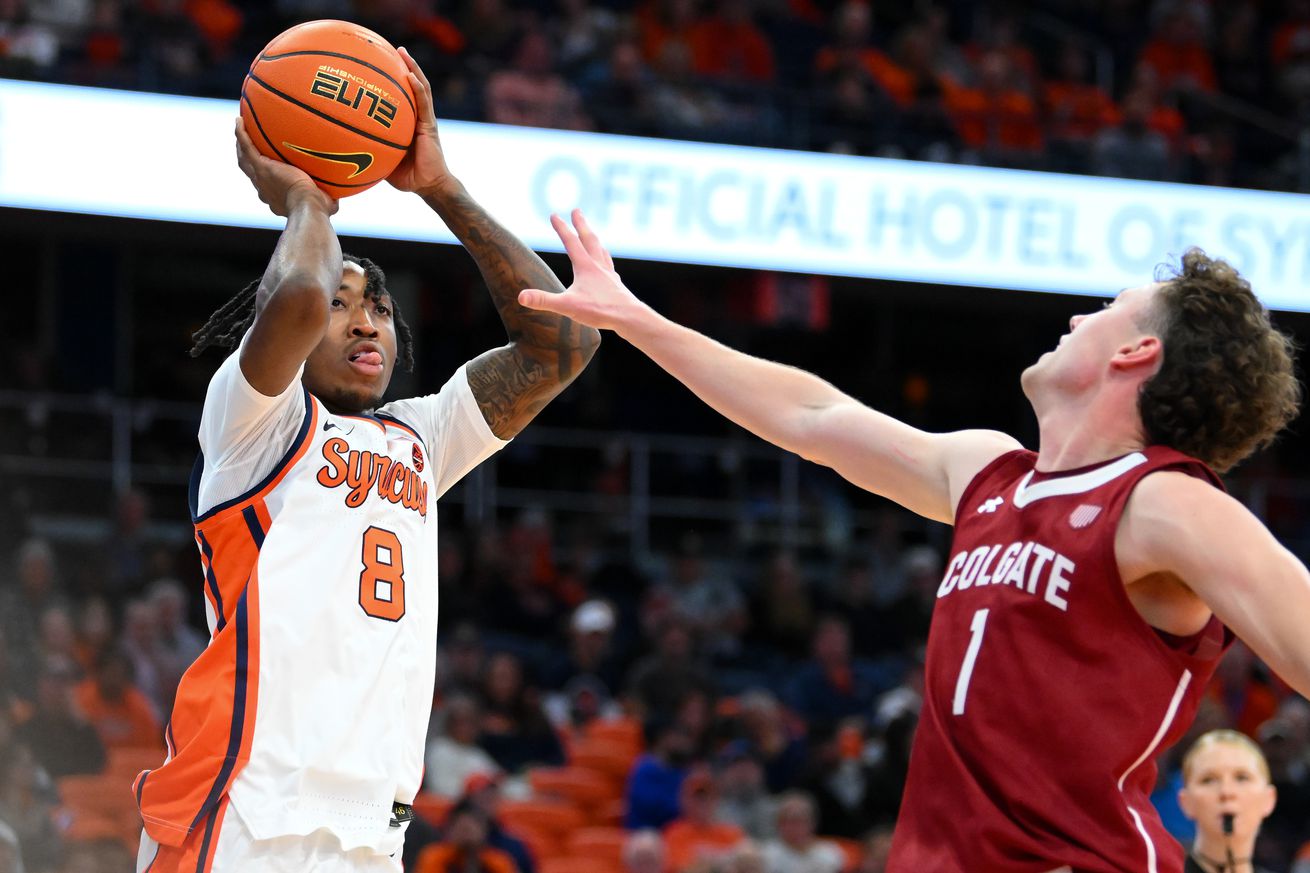
What there is to like (and not) about Syracuse’s offense after two games.
There’s two common themes that will be repeated early during the Syracuse Orange’s 2024-25 season so far.
First, don’t hit the panic button after a pair of games because there is still plenty of season left to go, tons more information to collect and a lot that can change. And second, considering the roster turnover during the offseason, it will take at least some time for things to mend together more.
With that said, considering Syracuse has had its share of struggles out of the gate and some critical non-conference games are looming on the horizon, there is at least enough to figure out what’s going right and what needs improvement. Sam already focused plenty on Syracuse’s defense in a different piece, but how about the Orange’s offense?
The results are certainly mixed. Before diving into the individual scoring numbers, let’s start off with the Orange’s shot location. This first chart is from CBB Analytics and breaks the court up into zones to see how efficient Syracuse is at different spots on the court.
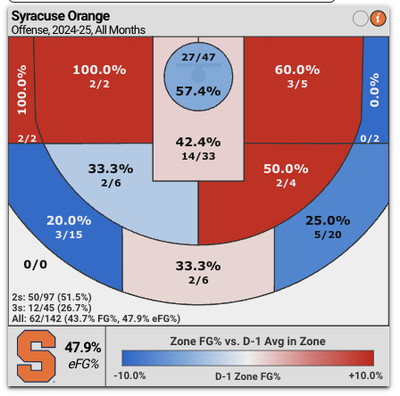
Chart and information according to CBB Analytics.
Some of the key takeaways that immediately jump out:
- Just under a third of the shots the Orange are taking (142 total) are from three, and the team is knocking down those attempts at a rate of under 27% (12/45). Per KenPom, Syracuse’s three-point percentage ranks 288th overall.
- 35 of the Orange’s 45 three-pointers attempted have been on the wing, making just 8/35 (below 23%) of those. Even more interesting, Syracuse has only gotten four corner three-pointers through two games.
- Syracuse is at least not settling for mid-range attempts or having that type of look be such a high percentage of the offense. Over 68% of the Orange’s total attempts have been in two-point range (97). Only 17 of Syracuse’s 97 two-point field goals have come in the mid-range, and the success rate for those has been pretty good in an albeit small sample size.
- In contrast, 80 of Syracuse’s two-point field goals have come either in the paint or upper-paint/floater range (just over 82%). The efficiency on those shots is a bit all over the place. Compared to the rest of the men’s CBB world, the Orange are shooting about average from that upper-paint area but are far more under water directly near the basket.
- One final key point: there isn’t a significant difference in volume between those paint and upper-paint shots (80 in total). For the Orange, about 59% of those are in the paint compared to 41% in the upper-paint.
The story out of the gate: Syracuse’s shot diet is actually pretty decent out of the gate. With that said, where the volume is higher, the efficiency has really only been strong in that upper-paint area and way lower directly in the paint and from three.
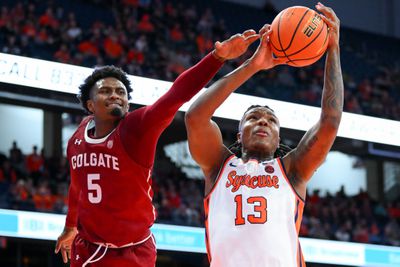
Rich Barnes-Imagn Images
Starting off on the perimeter, all players for the Orange who have taken more than two threes are shooting 33% or worse. That includes just two (Chris Bell and J.J. Starling) who are even north of 30% (writer’s note: players listed below are ordered based on total threes attempted so far this year):
- Chris Bell: 3/10, 30%
- J.J. Starling: 3/9, 33%
- Donnie Freeman: 1/6, 17%
- Lucas Taylor: 1/5, 20%
- Jaquan Carlos: 1/4, 25%
- Jyáre Davis: 1/4, 25%
- Elijah Moore: 0/4, 0%
Keep in mind that other key players in the rotation aren’t threats from the outside just based on the way they play. Eddie Lampkin Jr. knocked down his first career three versus Colgate. Petar Majstorovic has made one of his two attempts. If he cracks the rotation, Naheem McLeod plays pretty much around the rim.
Regardless of any adjustments that happen in the half-court, Syracuse collectively cannot be this below average shooting threes. That will make that floater range efficiency come down if opponents can just pack the paint and drives to the rim harder to complete. Even more important: Syracuse’s two main perimeter scorers (Starling and Bell) can’t also be the two-best shooters on the team, either. The hope is that Moore and Taylor can start to get things going and Carlos can make teams pay for going under the screen every now and then.
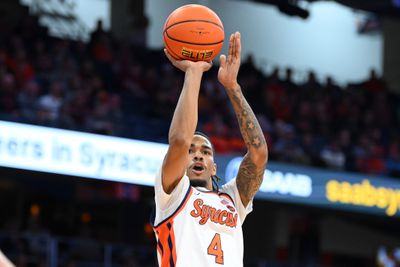
Rich Barnes-Imagn Images
Something else to consider: despite all those shots around the basket, Syracuse has really not gotten to the line at a high rate through two games. Defensively, Syracuse has actually been in the green in the percentage of free throws opponents are attempting versus field goals, but on offense, Syracuse ranks 260th in that category versus KenPom. Too many shots in two-point range are not leading to free trips to the line. Even then, Syracuse actually ranks 300th per KenPom in free throw efficiency, but considering the volume is so low, maybe that can improve as well with taking less of those floaters and more hardline drives to the basket.
This second chart looks just at the percentage of shots Syracuse is getting in each zone on the court. Again, a similar pattern appears: the Orange are getting a healthy amount of shots at the basket and floater range (56.3%), avoiding mid-range shots (just 11.9% of total attempts) and attempting a fair number of threes (31.7%, with a whopping 78% of those attempts coming from the two wings).
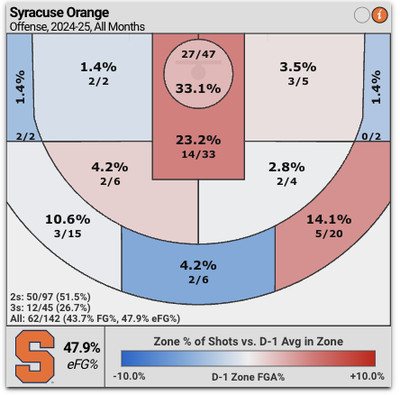
Chart and information according to CBB Analytics.
In the scoring department, there are some positives. Bell leads the team in scoring (17.0 PPG) and is just at 30% from three compared to 42% in 2023-24 (interestingly, his volume is also slightly down from three this year versus last season). If the three-pointer can climb back to at least the 38% to 40% range, that’s a valuable offensive hub there. Davis is 15.0 PPG, looks like a two-way spark and probably ranks as the best guy off the bench Syracuse can go to. Lampkin has had his moments and does legitimately give the Orange some presence in the paint. Looking at the whole team, KenPom does like the Orange in two pretty important categories: offensive rebounding percentage (75th) and turnover percentage (just 12.2%, 26th in the country).
The two things fans will likely point to as “offensive disappointments” so far, besides the outside shooting is that Starling is only third in scoring (13.0 PPG) and tied for third in shot attempts; for Syracuse to do anything, even if he isn’t the truest of number one guys, he has to command a higher usage than that. Then, Donnie Freeman is shooting just 6/19 out of the gate. Autry ended up going with Davis over Freeman to close out that Colgate game. Again he doesn’t need to be dominant, but there is room for improvement.
Overall, there’s some interesting trends coming from Syracuse’s offense after just two games. Looking at the entire picture, there’s some stuff to like and some stuff to not. Moving forward, let’s see what adjustments are made and how the scoring all gets sorted out as Syracuse continues forward this season.
Now it’s your turn: what are some of your early takeaways from the Orange’s offense so far in 2024-25? What adjustments are you interesting in seeing?